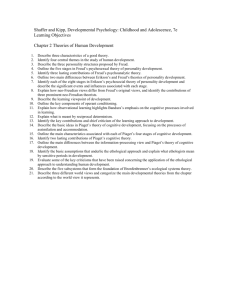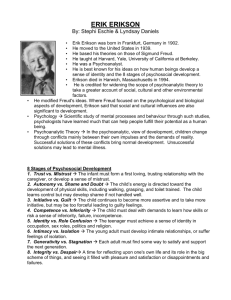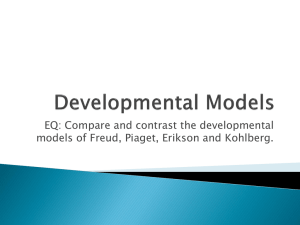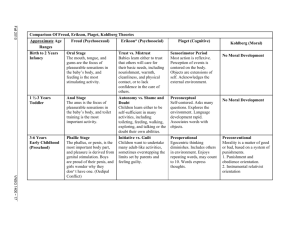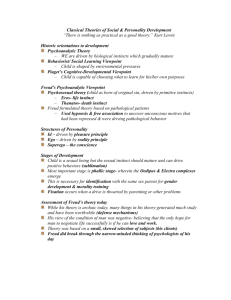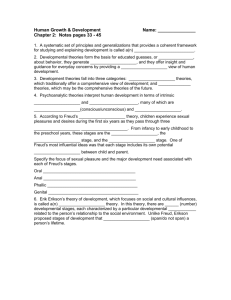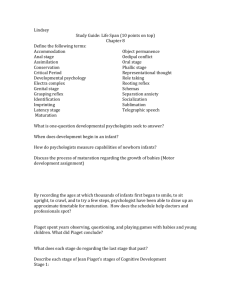Chapter 11
advertisement
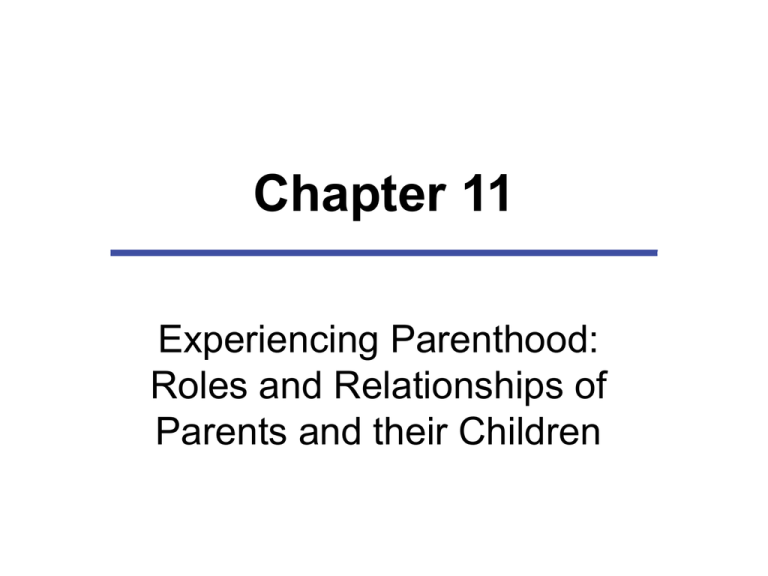
Chapter 11 Experiencing Parenthood: Roles and Relationships of Parents and their Children Chapter Outline • • • • • Being Parents Who Takes Care of the Children? Raising Children: Theories of Socialization, Advice to Parents and Styles of Parenting From the Theoretical to the Practical: Expert Advice on Child Rearing Styles and Strategies of Child Rearing Chapter Outline • • • • • What Influences Child Development? What Do Children Need? What Do Parents Need? Diversity in Parent-Child Relationships Parenting and Caregiving in Later Life True or False? • A maternal instinct has been proved to exist in humans. False • • Researchers are unable to find any purely instinctual motives for having children among humans. They do recognize social motives impelling women to become mothers. – From her earliest years, a woman has been trained to assume the role of mother. – The stories she heard, the games she played, the textbooks she read, the religion she has been taught, the television she watched—all socialized her for the mother role. True or False? • Studies consistently show that regular day care by nonfamily members is detrimental to intellectual and social development. False • High-quality child care, that is given by sensitive, responsive, and stimulating caregivers in a safe environment with low teacher-to-student ratio, can actually facilitate the development of positive social qualities, consideration, and independence. True or False? • Children of gay or lesbian parents are likely to be gay themselves. False Concerns about gay and lesbian parents tend to center on parenting abilities, fear of sexual abuse, and worry that the children will become gay or lesbian themselves. • Research has failed to support such concerns or identify negative outcomes for children. • Much research has failed to identify meaningful differences between children of gay and heterosexual parents. • The Ideology of Intensive Mothering Our cultural expectations of mothers as the essential caregivers. • Living up to its standards is difficult even for stay-at-home mothers. • For women employed outside the home, the ideology can provoke self-doubt, guilt, and a sense of being judged by others. • Bifurcation of Fatherhood Two sides of contemporary fatherhood, a result of the declining division of labor in the family. • By rejecting the notion of a father’s primary role as provider, some men felt “freed” from a sense of duty toward spouses and children. • Other men found that this liberated them to construct more expressive versions of fathering. • Who Takes Care of the Children? Childcare responsibility varies according to the marital status of parents and their employment roles and schedules. • In a two-parent family, care for children is more the responsibility of mothers than fathers. • It is estimated that fathers’ engagement with children is less than 45% that of mothers’. • Active Childcare Mothers take care of and think about their children more than fathers do. • For every hour fathers spend with their children, mothers spend 3 to 5 hours. • Fathers are more involved with sons than daughters,with younger children than older children, and with firstborn than later born children. • Non Parental Child Care 77% of the more than 8 million 3- to 5-yearolds are in nonparental child care. • 3 out of 4 children from families earning over $75,000 are in “center-based programs”. • Among children whose families earn less than $40,000, little more than half spend time in such programs. • Financial Support for Children Provided by Nonresident Fathers African American Hispanic Caucasian No support arranged or 0% paid 33.2% 36.4% 17.7% 1% to 99% of arranged support 13.6 9.5 — 100% of arranged support 54.2 54.1 82.3 Day Care Programs Suggested Standards – A lot of individual attention for each child – Trained, experienced teachers – The same day care staff for a long period – Opportunity for creative work, imaginative play, and physical activity Day Care Services Suggested Standards – Space to move indoors and out – Enough teachers and assistants ( at least 1 for every 5 children) – Ample drawing and coloring materials and toys, as well as swings, wagons, and jungle gyms – Small rather than large groups Day Care • • As more women return to the workforce, a critical issue is the quality of the day care for their children. High-quality day care can facilitate the development of positive social qualities. Freud’s Psychoanalytical Theory Holds that we are driven by an instinct to seek pleasure, especially sexual pleasure. – Id - Pleasure seeking part of personality – Superego - The conscience. – Ego - Mediates between the id and the constraints of society. • Freud viewed the parents as the primary force in a child’s psychological development. • Freud’s Psychoanalytical Theory • Freud divided psychosexual development into five stages spanning from birth through adolescence: 1. Oral 2. Anal 3. Phallic 4. Latency 5. Genital Erikson’s Psychoanalytic Theory Emphasized the effects of society on the developing ego, creating a model that has come to be known as psychosocial theory. • Each of Erikson’s life cycle stages is centered on a specific emotional concern based on biological influences and sociocultural expectations and actions. • Piaget’s Theory of Cognitive Development Suggested that cognitive development occurs in discrete stages for all infants and children. • Four stages of cognitive development: – Sensorimotor – Preoperational – Concrete operational – Formal operational • Developmental Systems Approach According to this approach, the growth and development of children takes place within a complex and changing family system that influences and is influenced by the child. • The family system is part of a number of larger systems all of which mutually interact. • Symbolic Interaction Theory Symbolic interactionists such as Charles Horton Cooley and George Herbert Mead stressed the processes through which we develop a social self, the sense of who we are and how we are perceived by those around us. • To interactionists, the self emerges out of interactions with others. • Symbolic Interaction Theory • In Cooley’s formulation, three key components comprise the looking-glass self, the self-concept that develops from our sense of how others view us: – We imagine how others perceive us. – We draw conclusions about how others judge us. – Based on these,we develop our ideas about ourselves. Symbolic Interaction Theory • Mead emphasized that the self consists of : – an active, spontaneous part ( “I”) – a more passive, acted upon part (“me”), in which we see ourselves as an object of other people’s actions toward us. Symbolic Interaction Theory • Play forces children to see things from someone else’s view, what Mead called “taking the role of the other”. – In the play stage (3 to 6 years old), children play at being specific individuals, often by dressing up. – By the game stage, they have developed enough self-awareness to be able to take into account multiple perspectives and anticipate how other players might act in a given situation. Stages of Development: Freud, Piaget, and Erikson Compared Freud Infancy Toddler Early childhood Oral Piaget Erikson Sensori-motor Trust vs. mistrust Anal Autonomy vs. shame and doubt Phallic Initiative vs. guilt Pre-operational Stages of Development: Freud, Piaget, and Erikson Compared Late-middle childhood Adolescence Freud Piaget Erikson Latency Concrete operational Industry vs. inferiority Genital Formal operational Identity vs. confusion Stages of Development: Freud, Piaget, and Erikson Compared Freud Piaget Erikson Early adulthood Intimacy vs. isolation Middle adulthood Generativity vs. stagnation Late adulthood Ego integrity vs. despair Contemporary Childrearing Strategies – Respect – Consistency and clarity – Logical consequences – Open communication – No physical punishment – Behavior modification Needs for Optimal Child Development Adequate prenatal nutrition and care. • Appropriate stimulation and care of newborns. • The formation of at least one close attachment during the first five years. • Needs for Optimal Child Development Support for the family including child care when a parent or parents must work. • Protection from illness. • Freedom from physical and sexual abuse. • Supportive friends, both adults and children. • Needs for Optimal Child Development Respect for the child’s individuality and appropriate challenges leading to competence. • Safe, nurturing, and challenging schooling. • An adolescence “free of pressure to grow up too fast, yet respectful of natural biological transformations” • Protection from premature parenthood. • Living Arrangements of Children in Households without Parents Arrangement Percentage of Children Grandparents 47.9 Grandparents and other relatives 27.6 Nonrelative guardians 21.9 Other arrangements 2.7 Gay and Lesbian Parents • Children of gay and lesbian parents generally: – Maintain close relationships with their parents. – Are well-adjusted. – Develop the same sexual orientations and gender roles as children of heterosexuals. Gay and Lesbian Parents • Families headed by lesbians or gay men experience the same joys and pains as those headed by heterosexuals, but they are also likely to face insensitivity or discrimination from society. % of Population, Age 30 Years or Older, Living with and Responsible for Grandchildren, 2000 % of Residential Grandparents Who Are Responsible for Grandchildren Grandparenting • • An important role for the middle-aged and aged. Three Styles of Grandparenting: 1. Companionate 2. Remote 3. Involved


